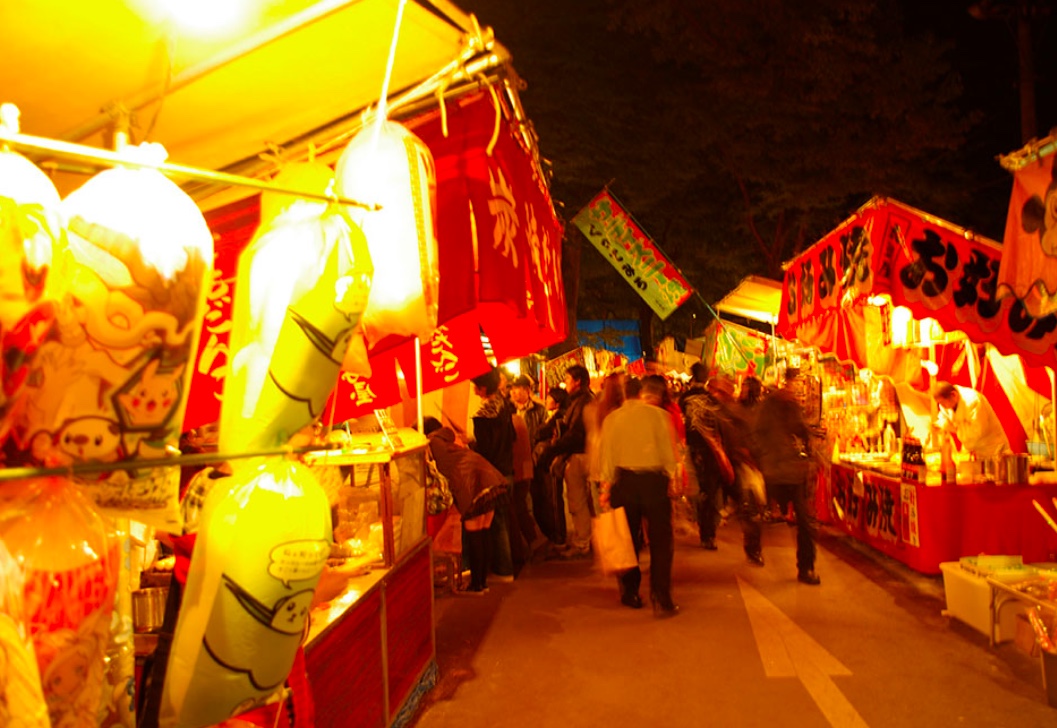What is Tekiya?
Tekiya refers to people who sell goods at local festivals, fairs, and temple/shrine approaches. Various types of food such as takoyaki and yakisoba, target practice, raffles, and goldfish scooping add to the extraordinary atmosphere of the festival. Tekiya gained momentum between 1600 and 1830, and began with a system in which people were invited to the fair to raise money for temple and shrine repairs and expansion, and also a portion of the proceeds from the sales was given to the temple and shrine as a place rent in exchange for being able to do business where large numbers of people gathered. After World War II, however, festivals and fairs declined and at the same time, Tekiya lost its momentum.
The original organizers were often gang related.
During the chaotic postwar period, there were many Tekiya organized by gangs, and it is believed that even today, many Tekiya are headed by gangsters. According to the Police White Paper of 1989, Tekiya, which was a street vendor at fairs to obtain funds after the war, and fools who repeatedly committed illegal acts in downtown areas expanded their power by selling goods and trafficking stimulants on the black market. Later, in the 1950s, the inclusive term “boryokudan” became socially accepted. The background to this is that they systematically used violence to solve problems within their territory and repeated confrontational battles over black-market concessions, which alarms the peace and order of the society.
Recently, crackdowns have been tightened.
Gang Exclusion Ordinances, which aim to cut off sources of funding for gangs, were it was enacted nationwide in 2011. In the midst of this, in November 2013, the “Prefectural Kanno Commercial Cooperative Association” (now dissolved), of which street vendors in Hyogo Prefecture were members, was found to have allegedly paid bouncer fees to gangsters. Of the annual fees collected from street vendors, approximately 3,000 yen was passed on to gangsters as unaccounted-for money. The control of Tekiya has been increasingly tightened, and also the regulations on road use permits and business licenses required for street vendors have become illiberal.
How Tekiya Works?
Tekiya, which has its roots in the 800s, still has a system that is considered tacit. It can be said that these rules are closely related to the gangs. Now, let’s focus on how Tekiya works and the largest Tekiya organization in Japan.
The types of businesses that are allowed to open a Tekiya are assigned.
When opening a Tekiya restaurant, to protect the interests of both parties, the location of the restaurant is allocated in advance to ensure that there is no overlap between Tekiya businesses. This allocation of space is called “teita-wari” or “dochi-wari,” etc. Until now, it has mostly been done by target-ya gangsters, who know the industry well and can restrain any problems that may arise. In addition to successfully allocating locations, the higher authority also directed the management of the garden area where the stalls were operated.
The Kyokuto-kai is famous
Japan’s largest organization of matoya-affiliated gangs is the well-known Kyokuto-kai, headquartered in Nishi-Ikebukuro, Tokyo. The term “boryokudan” was coined shortly after the end of World War II to describe a group of gamblers, street vendors (matoya), and juvenile delinquents (gurentai) who repeatedly fought over black-market interests. Among them, the “Kyokuto-kai” was known as a particularly martial group and repeatedly engaged in major conflicts with the Yamaguchigumi and is still a designated boryokudan.
The Yamaguchigumi war intensified. Yamaguchigumi is the largest designated gang in Japan; when Kazuo Taoka III died in the 1980s, the “Yamaichi War” broke out over the inheritance of the heir, resulting in many casualties. The Yamaichi War broke out in the 1980s over the inheritance of the heir, resulting in many deaths and injustice. However, conflicts surfaced within the Yamaguchigumi over management policies, and the organization split into the Kobe Yamaguchigumi and Ninkyo Yamaguchigumi, resulting in frequent incidents of disharmony. In this issue, we will look further into the causes of the intensifying conflicts.




Comments